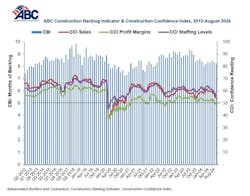Latest from Construction Data
Construction Labor Force Churn Accelerates in January
Sponsored
WASHINGTON, DC — Associated Builders and Contractors reported today that its Construction Backlog Indicator fell to 8.2 months in August, according to an ABC member survey conducted Aug. 20 to Sept. 5. The reading is down 1.0 months from August 2023.
Only the infrastructure category experienced a monthly increase in backlog among the three major segments, reflecting strength in public construction spending. Nonetheless, over the past year, backlog has declined in all three segments.
ABC’s Construction Confidence Index readings for sales, profit margins and staffing levels fell in August. The readings for sales and staffing levels remain above the threshold of 50, indicating expectations for growth over the next six months, while the reading for profit margin expectations fell below that threshold.
“As predicted, confidence among contractors is slipping,” said ABC Chief Economist Anirban Basu. “While ABC contractor members are still anticipating expanding sales and employment, profits margins are increasingly under pressure as project owners face high borrowing and construction delivery costs in the context of a slowing economy. Many projects have been postponed, resulting in recent backlog declines, most notably in the South.”
|
Note: The reference months for the Construction Backlog Indicator and Construction Confidence Index data series were revised on May 12, 2020, to better reflect the survey period. CBI quantifies the previous month's work under contract based on the latest financials available, while CCI measures contractors' outlook for the next six months. View the methodology for both indicators at www.abc.org. |
|
View ABC’s Construction Backlog Indicator and Construction Confidence Index tables for August, or view the full Construction Backlog Indicator and Construction Confidence Index data series by visiting www.abc.org.
Visit abc.org/economics for the Construction Backlog Indicator and Construction Confidence Index, plus analysis of spending, employment, job openings and the Producer Price Index.



